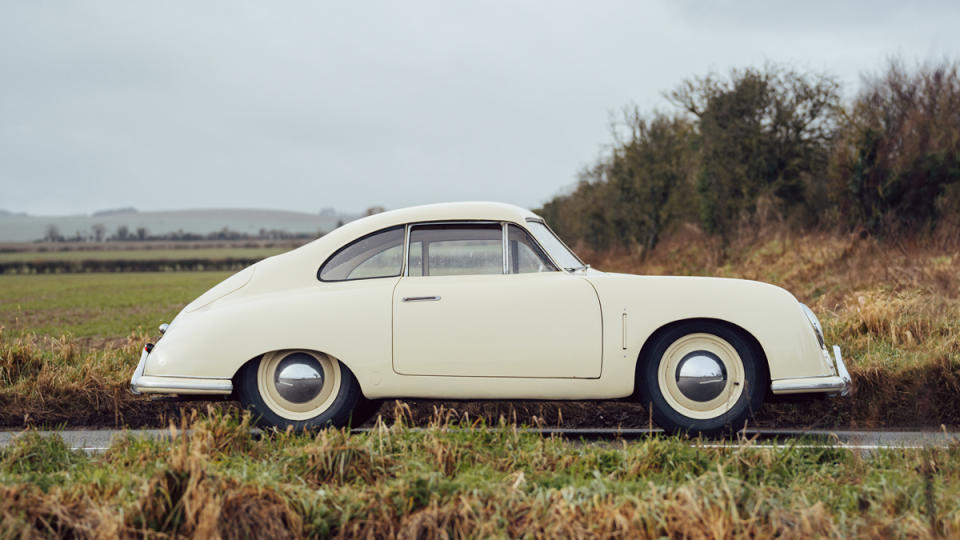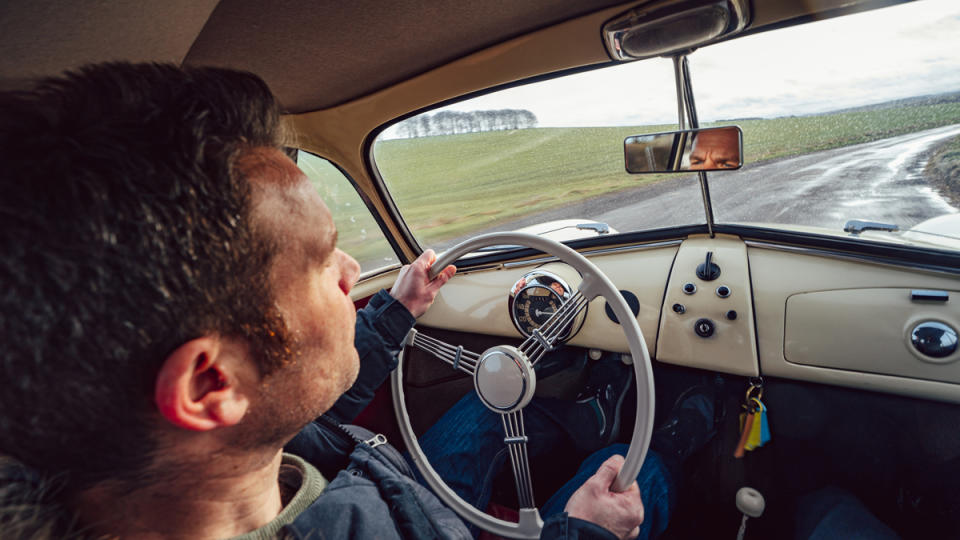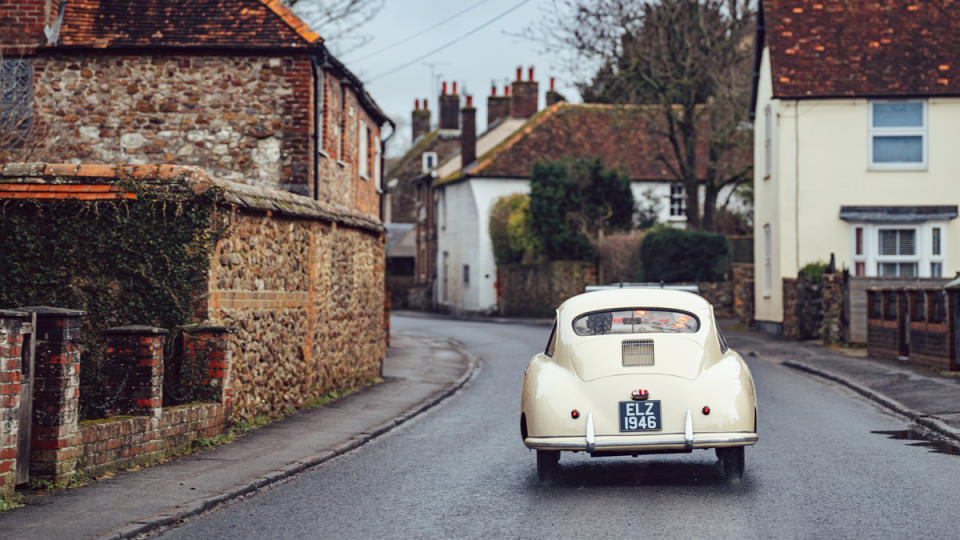Here’s What It’s Like to Drive a 1950 Porsche 356, One of the Marque’s First Sports Cars

With a grand total of 40 hp and a value of around $3.8 million, this little Porsche has the worst power-to-price ratio of any car I’ve ever driven. It seems like an inauspicious start. Then again, Porsche itself had a pretty inauspicious start.
In 1943, as World War II raged on, Porsche temporarily moved its headquarters to neighboring Austria. The sleepy mountain village of Gmünd provided the automaker shelter from the Allied forces working to defeat Hitler and Germany’s infamous attempt at global domination.
More from Robb Report
Car of the Week: The 1954 Pegaso Z-102 Was a Ferrari Killer, and This One Is Heading to Auction
These New State-of-the-Art Automotive Displays Will Showcase Your Car Like a Museum
Located inside a former sawmill, the Porsche factory was initially focused on the war effort. However, after the hostilities ended, Ferdinand “Ferry” Porsche pursued his dream to build a sports car. Revealed in 1948, the 356/1 prototype was a mid-engined roadster based on the Volkswagen Beetle.

The production 356/2 appeared soon afterwards, comprising a box-section steel frame and a hand-beaten-aluminum body. Yet there was one crucial difference: its engine had shifted rearwards, behind the back axle, to create more space for luggage and a pair of occasional rear seats. The template for the 911 was already in place.
A total of 52 examples of the Porsche 356 (44 coupes and eight convertibles) were assembled in Austria before the marque moved back to Stuttgart and switched to cheaper, heavier steel bodies. Today, any “Gmünd” 356 is highly collectable, with only around 30 cars thought to survive. Needless to say, the opportunity to drive one is a rare privilege.
This particular 356 coupe is chassis No. 32, sold in November of 1950 to a customer in Sweden. Its early years were spent competing in road rallies, including the 1952 Midnattssolsrallyt (Rally to the Midnight Sun), staged across 355 miles, which extended to the edge of the Arctic Circle. The car remained in Scandinavia until the late 1970s, then joined one of the world’s most significant Porsche collections in the United States. More recently, it was acquired by U.K.-based classics-specialist DK Engineering, where it’s now offered for sale.

A member of DK Engineering’s team has arrived at our photoshoot and drive in a new 911 GT3 RS, which is parked alongside the 356. The pair of automobiles could hardly look more different—one extroverted and aggressive, the other diminutive and understated—yet both clearly possess a shared DNA. Even people who have never heard of Weissach or Gmünd would recognize each car as a Porsche.
Details marking this vehicle out as an early 356 include a split windscreen, the lack of door locks (hey, it’s only $3.8 million) and pop-out “semaphore” indicators. Interestingly, the only Porsche badge is the script on the hood; the familiar Stuttgart shield wasn’t introduced until 1952.
Lift the engine lid and a 1.1-liter Volkswagen flat-four is tucked behind the rear bulkhead. Thanks to twin carburetors and high-compression heads, it musters 15 hp more than the engine in the Beetle, and drives the skinny rear wheels via a four-speed manual gearbox. Porsche didn’t quote any performance figures, but suffice to say it covers zero to 60 mph . . . eventually.

The 356’s magnolia paint is pockmarked and patinated, while its oxblood-leather seat is creased and cracked with age. That is “seat” in the singular, because both front occupants share a small, fixed-back couch. Oh, and there’s no adjustment for the driving position—luckily my 5’ 8” frame slots in perfectly. Anyone taller would be splayed around the enormous Bakelite-rimmed wheel.
Prod the start button (hidden beneath the dash panel) and the air-cooled engine splutters to life, its peashooter tailpipe rasping with breathy enthusiasm. I check and re-check the tiny rearview mirror, then ease the 74-year-old Porsche tentatively into 21st-century traffic. It gathers speed with a high-pitched whine from the transmission, underscored by the engine’s rhythmic boxer beat.
The lack of synchromesh means I have to double de-clutch with every gear shift. For the uninitiated, that means dipping the floor-hinged clutch pedal, shifting to neutral, releasing the clutch, and then pressing it again to select the next ratio up or down the ’box. Rush the process and you’ll hear an expensive crunch from the cogs. Work too slowly and you lose precious momentum, particularly when going up hills.

Speaking of hills, I’m stuck in second gear for even modest inclines, while fourth is too long-legged—given the Porsche’s power output—for all but the flattest and fastest of roads. I can imagine this museum piece blatting along Germany’s newly developed autobahn in 1950, one of the world’s first freeway networks. Today, it’s outpaced by even the smallest city cars.
Still, there’s simple pleasure in a vehicle that, in many situations, is scarcely capable of the speed limit. Where the driver of the GT3 RS would be forever holding back, using only a fraction of the car’s potential on public roads, I’m often pushing the 356 completely flat-out while behind the wheel. Driving becomes an exercise in planning ahead and working to maintain momentum.

Whether this early Porsche truly feels like a sports car is more debatable. There isn’t much steering feedback, and the suspension—trailing arms at the front and swing axles at the rear, borrowed from the Beetle—feels unsophisticated. The round drum brakes are also rather wooden, albeit sufficiently strong for the car’s performance.
I’m told that later versions of the 356 are more polished, but there’s still much to enjoy here—not least being the knowledge of driving a piece of Porsche history. From Speedster to Dakar, Carrera to Turbo, and GT2 to RSR, it all started in Gmünd.
Click here for more photos of this 1950 Porsche “Gmünd” 356.
Best of Robb Report
Sign up for Robb Report's Newsletter. For the latest news, follow us on Facebook, Twitter, and Instagram.


